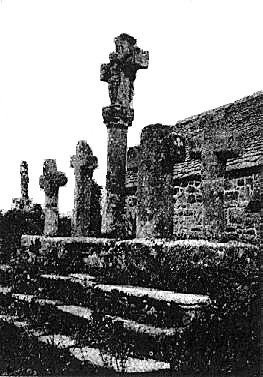(Matthew 27:38 and Luke 23:32).
This Is Appendix 164 From The Companion Bible.
Misled by tradion and the ignorance of Scripture
on the part of mediæval painters, it is the general belief that only
two were crucified with the Lord.
But Scripture does not say so. It states that there
were two "thieves" (Greek lestai = robbers,
Matthew 27: It is also recorded that both the
robbers reviled Him (Matthew 27: But the other discrepancy is, according to Matthew,
that after the parting of the garments, and
after "sitting down they watched Him there",
that "THEN" were there two robbers crucified
with Him, one on the right hand and the other on the left" (Matthew
27: The first two (malefactors) who were "led with
Him" were placed one on either side. When the other two (robbers)
were brought, much later, they were also similarly placed; so that there
were two (one of each) on either side and the Lord in the midst. The
malefactors were therefore the nearer, and being on the inside they could
speak to each other better, and the one with the Lord, as recorded (Luke
23: John's record confirms this for he speaks only of
place and not of time. He speaks, generally of
the fact: "where they crucified Him, and with Him
others, two on this side, and that side, and Jesus in the midst"
(John 19: But John further states (19: There are two words used of the "other"
and "others" in John 19:

THE FIVE CROSSES AT
PLOUBEZERE, NEAR LANNION,
Cotes-du-Nord, Brittany.
In the former passage we read, "they
brake the legs of the first and of the other." Here the
Greek is allos, which is the other (the second) of two
when there are more (see Matthew 10:23; 25:16, 17, 20: 27:61; 28:1. John
18:15,
16;
20:2, 4,
8, and
Revelation 17:10).
In the latter passage (Luke 23: From this evidence, therefore, it is clear that there
were four "others" crucified with the Lord; and thus, on the
hand, there are no "discrepancies", as alleged; while, on
the other hand, every word and every expression, in the Greek, gets (and
gives) its own exact value, and its full significance.
To show that we are not without evidence, even from
tradition, we may state that there is a "Calvary" to be seen
at Ploubézéré near Lannion, in the Côtes-du-Nord, Brittany, known as
Les Cinq Croix ("The Five Crosses"). There is
a high cross in the centre, with four lower ones, two on either side.
There may be other instances of which we have not heard.
"In the Roman Catholic church.... the
altar-slab or 'table' alone is consecrated, and in sign if
this are cut in its upper surface five Greek crosses, one in the centre
and one in each corner... but the history of the origin and development of
this practice is not fully worked out" (Encycl.
Brit., 11th (Cambridge) ed., vol. i, pages 762, 763). This
practice may possibly be explained by the subject of this Appendix.
1 Compare Matthew 6:21, 24; 8:21; 11:3. Luke 5:7; 6:6; 7:41; 9:56; 14:31; 16:13, 18; 17:34, 35; 18:10; 23:40.